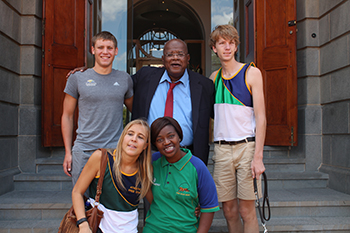Latest News Archive
Please select Category, Year, and then Month to display items
05 June 2018
Photo Supplied
 Archaeological excavations in the Wonderwerk Cave, north of Kuruman in the Northern Cape.
Archaeological excavations in the Wonderwerk Cave, north of Kuruman in the Northern Cape.
Research fellow Dr Lloyd Rossouw from the Department of Plant Sciences at the University of the Free State (UFS) recently published an article in the Nature Ecology and Evolution journal with Dr Michaela Ecker from the University of Toronto as lead author, and Dr James Brink, research fellow at the UFS Centre for Environmental Management. The findings described in “The palaeoecological context of the Oldowan-Acheulean in southern Africa” provides the first extensive paleoenvironmental sequence for the interior of southern Africa by applying a combination of methods for environmental reconstruction at Wonderwerk Cave, which have yielded multiple evidence of early human occupation dating back almost two million years ago.
Where water once was
The Wonderwerk Cave is found north of the Kuruman hills (situated in Northern Cape) a 140m long tube with a low ceiling. The surroundings are harsh. Semi-arid conditions allow for the survival of only hardy bushes, trees, and grasses. But during the Early Pleistocene, stepping out of the Wonderwerk Cave you would have been greeted by a completely different site, the researchers found. Using carbon and oxygen stable isotope analysis on the teeth of herbivores (Dr Ecker), fossil faunal abundance (Dr Brink), as well as the analysis of microscopic plant silica remains (phytoliths) excavated from fossil soils inside the cave (Dr Rossouw), the results show that ancient environments in the central interior of southern Africa were significantly wetter and housed a plant community unlike any other in the modern African savanna.
What difference does it make?
While East African research shows increasing aridity and the spread of summer-rainfall grasslands more than a million years ago, the results from this study indicate an interesting twist. During the same period, shifts in rainfall seasonality allowed for alternating summer and winter-rainfall grass occurrences coupled with prolonged wetlands, that remained major components of Early Pleistocene (more or less the period between one and two million years ago) environments in the central interior of southern Africa. That means our human ancestors were also living and evolving in environments other than the generally accepted open, arid grassland model.
Five Kovsies competing at National Championship for Physically Disabled
2016-03-18

Students from the University of the Free State (UFS) will compete at the Nedbank National Championship for the Physically Disabled in Bloemfontein from 21–23 March 2016. From back left is Johann van Heerden, Prof Jonathan Jansen, Vice-Chancellor and Rector of the UFS, and Danie Breitenbach. Front from left is Louzanne Coetzee and Dineo Mokhosoa.
Photo: Jóhann Thormählen |
Five students from the University of the Free State (UFS) will be taking part in the Nedbank National Championship for the Physically Disabled from 21–23 March 2016 in Bloemfontein. Dineo Mokhosoa, Juanré Jenkinson, Louzanne Coetzee, Danie Breitenbach and Johann van Heerden will represent the Free State at this event – one of the last opportunities to qualify for the Paralympic Games.
According to Martie Miranda, Head of the Center for Universal Access and Disability Support (CUADS) at the UFS, these students have shown they can achieve anything. “The Center for Universal Access and Disability Support is extremely proud of our students with disabilities who excel in sport and wish our students the best of luck with the national championships,” she said.“They confirm that ‘impossible’ is just a word.”
Most of the students already have excellent national and international rankings in their respective categories.
Mokhosoa (Cerebral Palsy), is ranked first in South Africa in discus, shot-put and long jump. This Social Work student also has two South African records in shot-put and long jump respectively behind her name. Jenkinson (Cerebral Palsy) is ranked eighth in the world in shot-put.
Coetzee (blind), who competes in the 800 m, 1 500 m and 5 000 m, is fifth in the world in the 800 m and ninth in the 1500 m. Breitenbach (blind) runs 400 m, 800 m and 1 500 m. Breitenbach, a Law student, is ranked fifth in the world in the 800 m.
Van Heerden (Cerebral Palsy) competes in swimming in the 50 m, 100 m and 200 m breaststroke. The Education student is ranked third in the 50 m, seventh in the 100 m and third in the 200 m in the world.
The Paralympic Games is taking place in September 2016 in Rio de Janeiro, Brazil.